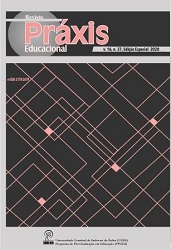ALCANZAR EL CONSENSO: UNA REVISIÓN DE ALCANCE SOBRE LOS PROGRAMAS DE EDUCACIÓN INTEGRAL EN SEXUALIDAD (CSE) BASADOS EN LA ESCUELA
DOI:
https://doi.org/10.22481/praxisedu.v16i37.6175Palabras clave:
Revisión del alcance, Educación integral en sexualidad, Base escolar, JuventudResumen
La educación sexual en las escuelas es un tema candente en parte porque está estrechamente entrelazado con las interpretaciones sociales y parentales de lo correcto y lo incorrecto. Este estudio es una revisión de alcance que se realizó en seis pasos: (1) identificación de la pregunta de investigación, (2) identificación de estudios relevantes, (3) selección de estudios, (4) extracción de datos, (5) resumen e informe resultados, y (6) consulta con las partes interesadas. Los currículos se evaluaron mediante la Herramienta de evaluación curricular (SIECUS) y las directrices se evaluaron mediante la evaluación de las directrices para la herramienta de investigación y evaluación (AGREE II). Después de revisar 24 programas extraídos de 50 estudios, la mayoría de los cuales (90%) fueron diseñados y utilizados en países en desarrollo, se respondieron 5 preguntas. Finalmente, se recomendaron con modificaciones las pautas de “Pautas para el componente de educación en salud sexual de la educación integral en salud” y los planes de estudio “FLEHI, WSWM, Tuko Pamoja”. Esta revisión muestra que los programas de CSE no son solo intervenciones rentables, sino también parte de los derechos sexuales de los adolescentes. Al comienzo del programa, puede haber muchas barreras sociales y culturales en los países en desarrollo, pero una vez que se diseña un programa riguroso de base cultural, se pueden lograr resultados exitosos. Por lo tanto, se recomienda encarecidamente diseñar tales programas basados en la cultura iraní.
Descargas
Métricas
Citas
Adolescent Health Research Priorities: Report of a Technical Consultation. Geneva: World Health Organization. 2015.
Apter, D. (2011). Recent developments and consequences of sexuality education in Finland. Paper presented at the FORUM Sexuality Education and Family Planning.
Behague, S., Christenson, K., Martin, S., Wysong, M., & Kibusu, K. (2006). Tuko Pamoja: adolescent reproductive health and life skills curriculum.
Berkowitz, M. W., & Bier, M. C. (2007). What works in character education. Journal of Research in Character Education, 5(1), 29.
Berne, L., Huberman, B., & Alford, S. (1999). European approaches to adolescent sexual behavior and responsibility: executive summary and call to action. Washington, DC: Advocates for Youth.
Chandra-Mouli, V., Plesons, M., Hadi, S., Baig, Q., & Lang, I. (2018). Building support for adolescent sexuality and reproductive health education and responding to resistance in conservative contexts: Cases from Pakistan. Global Health: Science and Practice, 6(1), 128-136.
Chin, H. B., Sipe, T. A., Elder, R., Mercer, S. L., Chattopadhyay, S. K., Jacob, V., . . . Griffith, M. (2012). The effectiveness of group-based comprehensive risk-reduction and abstinence education interventions to prevent or reduce the risk of adolescent pregnancy, human immunodeficiency virus, and sexually transmitted infections: two systematic reviews for the Guide to Community Preventive Services. American journal of preventive medicine, 42(3), 272-294.
Collins, C., Alagiri, P., Summers, T., & Morin, S. F. (2002). Abstinence only vs. comprehensive sex education: What are the arguments? What is the evidence?
Consortium, A. N. S. (2009). Appraisal of guidelines for research and evaluation II instrument. Retrieved May, 12, 2011.
Farahani, F. K. A., Shah, I., Cleland, J., & Mohammadi, M. R. (2012). Adolescent males and young females in Tehran: differing perspectives, behaviors and needs for reproductive health and implications for gender sensitive interventions. Journal of Reproduction & Infertility, 13(2), 101.
Fonner, V. A., Armstrong, K. S., Kennedy, C. E., O'Reilly, K. R., & Sweat, M. D. (2014). School Based Sex Education and HIV Prevention in Low- and Middle-Income Countries: A Systematic Review and Meta-Analysis. PloS one, 9(3), e89692. doi: 10.1371/journal.pone.0089692
Haruna, H., Hu, X., & Chu, S. K. W. (2018). Adolescent School-Based Sexual Health Education and Training: A Literature Review on Teaching and Learning Strategies. Glob. J. Health Sci, 10, 172. http://www.actionhealthinc.org/publication/. . https://portal.ct.gov/.../Sexual-Health...Health.../Sexual-Health-Education- Curriculum-Framework.
Huaynoca, S., Chandra-Mouli, V., Yaqub Jr, N., & Denno, D. M. (2014). Scaling up comprehensive sexuality education in Nigeria: from national policy to nationwide application. Sex Education, 14(2), 191-209. doi: 10.1080/14681811.2013.856292
Information, S., & States, E. C. o. t. U. (2004). Guidelines for comprehensive sexuality education: Kindergarten-12th grade: Author New York.
Initiative, F. o. S. E. (2012). National sexuality education standards: Core content and skills, K-12 [a special publication of the Journal of School Health]. Retrieved May 23 2014 from.
Kirby, D. (2002). The impact of schools and school programs upon adolescent sexual behavior. Journal of sex research, 39(1), 27-33.
Kirby, D., & Laris, B. (2009). Effective curriculum‐based sex and STD/HIV education programs for adolescents. Child Development Perspectives, 3(1), 21-29.
Kirby, D. B. (2008). The impact of abstinence and comprehensive sex and STD/HIV education programs on adolescent sexual behavior. Sexuality Research & Social Policy, 5(3), 18.
Kirby, D. B., Laris, B., & Rolleri, L. A. (2007). Sex and HIV education programs: their impact on sexual behaviors of young people throughout the world. Journal of Adolescent Health, 40(3), 206-217.
Kivela, J., Haldre, K., Part, K., Ketting, E., & Baltussen, R. (2014). Impact and cost-effectiveness analysis of the national school-based sexuality education programme in Estonia. Sex Education, 14(1), 1-13.
Kivela, J., Ketting, E., & Baltussen, R. (2013). Cost analysis of school-based sexuality education programs in six countries. Cost effectiveness and resource allocation, 11(1), 17.
Levac, D., Colquhoun, H., & O'Brien, K. K. (2010). Scoping studies: advancing the methodology. Implementation science, 5(1), 69.
Lima, D. K. S., Schoeller, S. D., da Silva Knihs, N., Vargas, C. P., Tholl, A. D., Lopes, S. G. R., . . . de Almeida Hammerschmidt, K. S. (2017). Protocol for a scoping review of skin self-care of people with spinal cord injury. BMJ open, 7(9), e017860.
Mathews, C., Aarø, L., Grimsrud, A., Flisher, A., Kaaya, S., Onya, H., . . . Klepp, K.-I. (2012). Effects of the SATZ teacher-led school HIV prevention programmes on adolescent sexual behaviour: cluster randomised controlled trials in three sub-Saharan African sites. International Health, 4(2), 111-122.
Mohammadi, M. R., Mohammad, K., Farahani, F. K., Alikhani, S., Zare, M., Tehrani, F. R., . . . Alaeddini, F. (2006). Reproductive knowledge, attitudes and behavior among adolescent males in Tehran, Iran. International family planning perspectives, 35-44.
Organization, W. H. (2017). Adolescent health research priorities: report of a technical consultation, WHO reference number: WHO: FWC/MCA/15/07.
Rijsdijk, L. E., Bos, A. E., Ruiter, R. A., Leerlooijer, J. N., de Haas, B., & Schaalma, H. P. (2011). The World Starts With Me: A multilevel evaluation of a comprehensive sex education programme targeting adolescents in Uganda. BMC public health, 11(1), 334.
Roy, S., Roy, S., & Rangari, K. (2007). Comprehensive health care including sexual and reproductive health of adolescents and youths is of vital importance to the nation. Health and Population-Perspectives and Issues, 30(4), 243-267.
Sajjadi, M., Moshki, M., Abasnezhad, A., & Bahri, N. (2012). Educational needs of fathers about boys puberty period and its related factors. Zahedan Journal of Research in Medical Sciences, 14(2), 66-70.
Samadaee-Gelehkolaee, K., McCarthy, B. W., Khalilian, A., Hamzehgardeshi, Z., Peyvandi, S., Elyasi, F., & Shahidi, M. (2016). Factors Associated With Marital Satisfaction in Infertile Couple: A Comprehensive Literature Review. Global journal of health science, 8(5), 96.
Schutte, L., Meertens, R. M., Mevissen, F. E., Schaalma, H., Meijer, S., & Kok, G. (2014). Long Live Love. The implementation of a school-based sex-education program in the Netherlands. Health education research, 29(4), 583-597.
Stanger-Hall, K. F., & Hall, D. W. (2011). Abstinence-only education and teen pregnancy rates: why we need comprehensive sex education in the US. PloS one, 6(10), e24658.
Udegbe, B. I., Fayehun, F., Isiugo-Abanihe, U. C., Nwagwu, W., Isiugo-Abanihe, I., & Nwokocha, E. (2015). Evaluation of the implementation of family life and HIV education programme in Nigeria. African journal of reproductive health, 19(2), 79-92.
UNFPA. (2014). Operational Guidance for Comprehensive Sexuality Education: A Focus on Human Rights and Gender: UNFPA New York.
Wight, D., & Buston, K. (2003). Meeting needs but not changing goals: evaluation of in-service teacher training for sex education. Oxford Review of Education, 29(4), 521-543.
Wolfe, D. A., Crooks, C., Jaffe, P., Chiodo, D., Hughes, R., Ellis, W., . . . Donner, A. (2009). A school-based program to prevent adolescent dating violence: A cluster randomized trial. Archives of pediatrics & adolescent medicine, 163(8), 692-699.
Women, U., & UNICEF. (2018). International technical guidance on sexuality education: an evidence-informed approach: UNESCO Publishing.
www.behdasht.gov.ir/index.aspx?siteid=1&pageid=156.
Zare, E., Simbar, M., Shahhosseini, Z., & Alavi Majd, H. (2017a). The Priorities of Iranian Male Adolescents Health Needs. American Journal of Men's Health, 1557988317693346.
Zare, E., Simbar, M., Shahhosseini, Z., & Alavi Majd, H. (2017b). The Priorities of Iranian Male Adolescents Health Needs. American Journal of Men's Health, 11(4), 1255-1259.
Descargas
Publicado
Cómo citar
Número
Sección
Licencia
Usted es libre de:
Compartir — copiar y redistribuir el material en cualquier medio o formato; Adaptar — remezclar, transformar y construir a partir del material para cualquier propósito, incluso comercialmente. Esta licencia es aceptable para Obras Culturales Libres. La licenciante no puede revocar estas libertades en tanto usted siga los términos de la licencia.
Bajo los siguientes términos:
Atribución — Usted debe dar crédito de manera adecuada, brindar un enlace a la licencia, e indicar si se han realizado cambios. Puede hacerlo en cualquier forma razonable, pero no de forma tal que sugiera que usted o su uso tienen el apoyo de la licenciante.
No hay restricciones adicionales — No puede aplicar términos legales ni medidas tecnológicas que restrinjan legalmente a otras a hacer cualquier uso permitido por la licencia.










